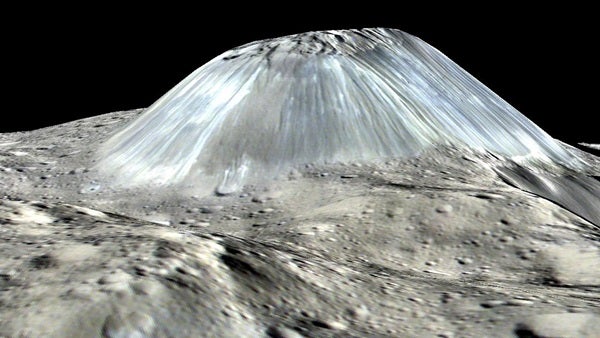In 2015, NASA’s Dawn spacecraft discovered a lone 4-km (2.5-mile) high mountain on the dwarf planet Ceres. Identified as a cryovolcano, which erupts ice and other volatiles instead of lava like a traditional volcano, Ahuna Mons was magnificent but alone on Ceres’ surface. Now, however, scientists say that Ceres may have been home to many more such cryovolcanoes in the past, which could have slowly disappeared and left Ahuna Mons as the only remaining feature of recent geologic activity.
Michael Sori of the Lunar and Planetary Laboratory at the University of Arizona in Tucson is the lead author of a new paper accepted for publication in the American Geophysical Union’s journal, Geophysical Research Letters. In recent a press release, Sori explains why Ahuna Mons is such a mystery, saying, “Imagine if there was just one volcano on all of Earth. That would be puzzling.” But Sori’s team has now proposed a possible solution to this exact puzzle, a process called viscous relaxation. If this process is truly at work on Ceres, then, “We think we have a very good case that there have been lots of cryovolcanoes on Ceres but they have deformed,” Sori says.
Viscous relaxation refers to the flow of solids over time. On Earth, the best example of this process is the flow of glaciers, which are solid ice but move and flow slowly, given enough time. While viscous relaxation doesn’t apply to Earth’s volcanoes, which are made of rock, it could apply to cryovolcanoes, which are made of ice, just like glaciers. Sori’s team speculates that older cryovolcanoes have undergone such viscous relaxation over the past few millions or billions of years, possibly aided by Ceres’ close orbit to the sun. This would leave only the younger Ahuna Mons clearly visible on Ceres’ surface. Based on computer models of this process, and assuming that Ahuna Mons is composed of at least 40 percent water, Sori’s team estimates that this feature would flatten out at a rate of 10-50 meters (30-160 feet) every million years. But because Ahuna Mons is only 200 million years old at most, “it just hasn’t had time to deform,” Sori explains.
Sori’s team now aims to identify the remnants of past cryovolcanoes that have undergone such flattening, which would be the evidence needed to prove their hypothesis. If such features are found, it will help astronomers better understand Ceres’ history — information that could be extrapolated to other icy worlds throughout the solar system as well.










